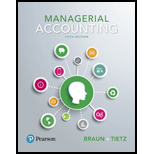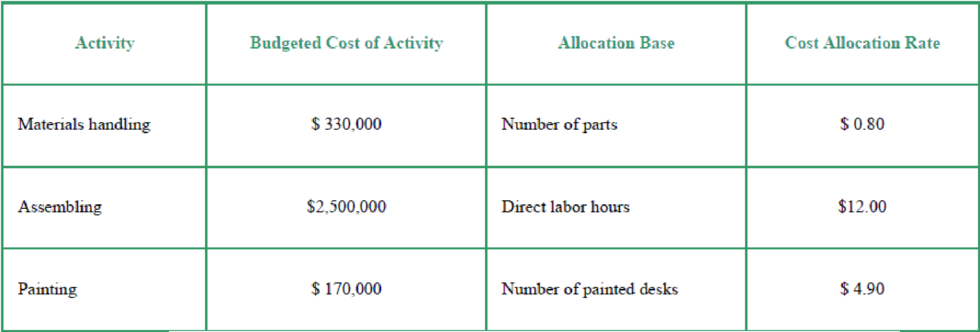
Managerial Accounting, Student Value Edition (5th Edition)
5th Edition
ISBN: 9780134067179
Author: Karen W. Braun, Wendy M. Tietz
Publisher: PEARSON
expand_more
expand_more
format_list_bulleted
Concept explainers
Textbook Question
Chapter 4, Problem 4.42AP
Use ABC to compute full product costs (Learning Objective 2)
Arnett Corp. manufactures computer desks in its White Bear Lake, Minnesota, plant. The company uses activity-based costing to allocate all manufacturing conversion costs (direct labor and manufacturing

Arnett produced two styles of desks in March: the Standard desk and the Unpainted desk. Data for each follow:

 Requirements
Requirements
- 1. Compute the per-unit manufacturing product cost of Standard desks and Unpainted desks.
- 2. Premanufacturing activities, such as product design, were assigned to the Standard desks at $6 each and to the Unpainted desks at $2 each. Similar analyses were conducted of post-manufacturing activities, such as distribution, marketing, and customer service. The post-
manufacturing costs were $22 per Standard and $19 per Unpainted desk. Compute the full product costs per desk. - 3. Which product costs are reported in the external financial statements? Which costs are used for management decision making? Explain the difference.
- 4. What price should Arnett’s managers set for Standard desks to earn a $42 profit per desk?
Expert Solution & Answer
Want to see the full answer?
Check out a sample textbook solution
Students have asked these similar questions
Calculate the predetermined overhead rate based on direct labor hours
Solve this financial accounting problem
Given true answer financial accounting
Chapter 4 Solutions
Managerial Accounting, Student Value Edition (5th Edition)
Ch. 4 - (Learning Objective 1) Cost distortion is more...Ch. 4 - (Learning Objective 2) The first step in computing...Ch. 4 - (Learning Objective 2) Activities incurred...Ch. 4 - (Learning Objective 3) Which of the following is...Ch. 4 - (Learning Objective 3) The potential benefits of...Ch. 4 - (Learning Objective 4) Lean operations are...Ch. 4 - Prob. 7QCCh. 4 - (Learning Objective 4) Concerning lean operations,...Ch. 4 - (Learning Objective 5) Which of the following is...Ch. 4 - (Learning Objective 5) Which of the following...
Ch. 4 - Understanding key terms (Learning Objectives 1, 2,...Ch. 4 - Use departmental overhead rates to allocate...Ch. 4 - Compute departmental overhead rates (Learning...Ch. 4 - Prob. 4.4SECh. 4 - Prob. 4.5SECh. 4 - Calculate a job cost using ABC (Learning Objective...Ch. 4 - Classifying costs within the cost hierarchy...Ch. 4 - Classifying costs within the cost hierarchy...Ch. 4 - Determine the usefulness of refined costing...Ch. 4 - Prob. 4.10SECh. 4 - Identifying costs as value-added or...Ch. 4 - Identify lean production characteristics (Learning...Ch. 4 - Identify the DOWNTIME activities at a manufacturer...Ch. 4 - Prob. 4.14SECh. 4 - Classifying costs of quality (Learning Objective...Ch. 4 - Quality initiative decision (Learning Objective 5)...Ch. 4 - Assess the impact of a quality initiative...Ch. 4 - Identify ethical standards violated (Learning...Ch. 4 - Compare traditional and departmental cost...Ch. 4 - Compute activity rates and apply to jobs (Learning...Ch. 4 - Apply activity cost allocation rates (Learning...Ch. 4 - Using ABC to bill clients at a service firm...Ch. 4 - Compare traditional and ABC allocations at a...Ch. 4 - Compare traditional and ABC allocations on a job...Ch. 4 - Use ABC to allocate manufacturing overhead...Ch. 4 - Continuation of E4-25A: Determine product...Ch. 4 - Prob. 4.27AECh. 4 - Classify costs and make a quality-initiative...Ch. 4 - Prob. 4.29AECh. 4 - Compare traditional and departmental cost...Ch. 4 - Prob. 4.31BECh. 4 - Prob. 4.32BECh. 4 - Prob. 4.33BECh. 4 - Compare traditional and ABC cost allocations at a...Ch. 4 - Prob. 4.35BECh. 4 - Prob. 4.36BECh. 4 - Prob. 4.37BECh. 4 - Prob. 4.38BECh. 4 - Classify costs and make a quality-initiative...Ch. 4 - Prob. 4.40BECh. 4 - Prob. 4.41APCh. 4 - Use ABC to compute full product costs (Learning...Ch. 4 - Prob. 4.43APCh. 4 - Prob. 4.44APCh. 4 - Prob. 4.45APCh. 4 - Prob. 4.46BPCh. 4 - Prob. 4.47BPCh. 4 - Comprehensive ABC implementation (Learning...Ch. 4 - Using ABC in conjunction with quality decisions...Ch. 4 - Comprehensive ABC (Learning Objectives 2 3)...Ch. 4 - Prob. 4.51SCCh. 4 - Discussion Questions 1. Explain why departmental...Ch. 4 - ABC in Real Companies Choose a company in any of...Ch. 4 - Value-Added versus Non-Value-Added at a Restaurant...Ch. 4 - Ethics involved with ABC and hazardous waste costs...
Knowledge Booster
Learn more about
Need a deep-dive on the concept behind this application? Look no further. Learn more about this topic, accounting and related others by exploring similar questions and additional content below.Similar questions
- Need Ans financial accountingarrow_forwardBijal Enterprises has a break-even point of 1,500 units. The sales price per unit is $20, and the variable cost per unit is $14. If the company sells 3,800 units, what will its net income be? help mearrow_forwardAnswer this without using Chatgtp or AIarrow_forward
- Compute the overhead allocation ratearrow_forwardKendall Corporation uses the weighted-average method in its process costing system. The ending work in process inventory consists of 10,000 units. The ending work in process inventory is 100% complete with respect to materials and 60% complete with respect to labor and overhead. If the cost per equivalent unit for the period is $4.00 for materials and $1.50 for labor and overhead, what is the balance of the ending work in process inventory account?arrow_forwardIf the current market price for selling a product at Andrew Materials is $15.50 per unit, and the company wishes to make a 12% profit, what is the target cost? Accurate answerarrow_forward
arrow_back_ios
SEE MORE QUESTIONS
arrow_forward_ios
Recommended textbooks for you
 Managerial Accounting: The Cornerstone of Busines...AccountingISBN:9781337115773Author:Maryanne M. Mowen, Don R. Hansen, Dan L. HeitgerPublisher:Cengage Learning
Managerial Accounting: The Cornerstone of Busines...AccountingISBN:9781337115773Author:Maryanne M. Mowen, Don R. Hansen, Dan L. HeitgerPublisher:Cengage Learning Cornerstones of Cost Management (Cornerstones Ser...AccountingISBN:9781305970663Author:Don R. Hansen, Maryanne M. MowenPublisher:Cengage Learning
Cornerstones of Cost Management (Cornerstones Ser...AccountingISBN:9781305970663Author:Don R. Hansen, Maryanne M. MowenPublisher:Cengage Learning Excel Applications for Accounting PrinciplesAccountingISBN:9781111581565Author:Gaylord N. SmithPublisher:Cengage Learning
Excel Applications for Accounting PrinciplesAccountingISBN:9781111581565Author:Gaylord N. SmithPublisher:Cengage Learning

Managerial Accounting: The Cornerstone of Busines...
Accounting
ISBN:9781337115773
Author:Maryanne M. Mowen, Don R. Hansen, Dan L. Heitger
Publisher:Cengage Learning

Cornerstones of Cost Management (Cornerstones Ser...
Accounting
ISBN:9781305970663
Author:Don R. Hansen, Maryanne M. Mowen
Publisher:Cengage Learning

Excel Applications for Accounting Principles
Accounting
ISBN:9781111581565
Author:Gaylord N. Smith
Publisher:Cengage Learning
Cost Accounting - Definition, Purpose, Types, How it Works?; Author: WallStreetMojo;https://www.youtube.com/watch?v=AwrwUf8vYEY;License: Standard YouTube License, CC-BY